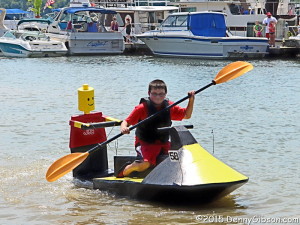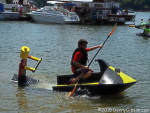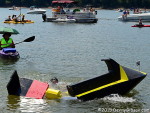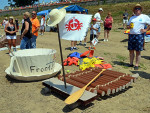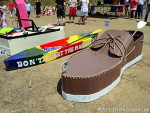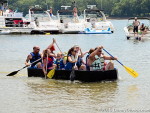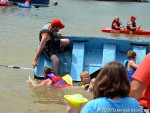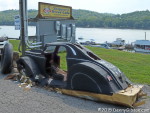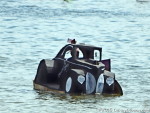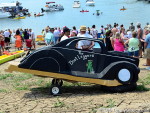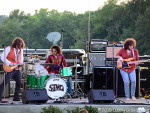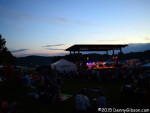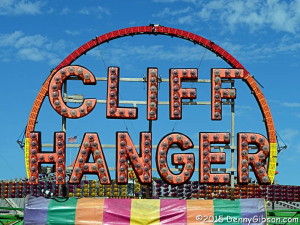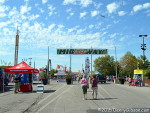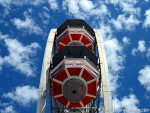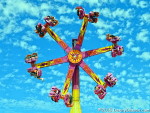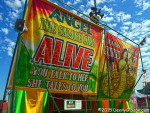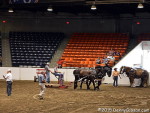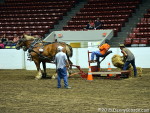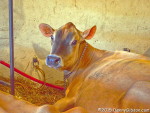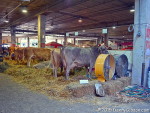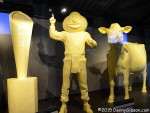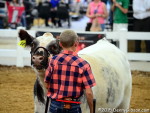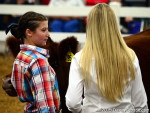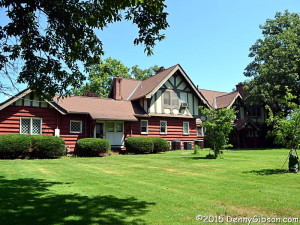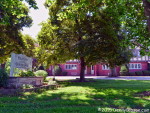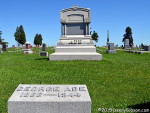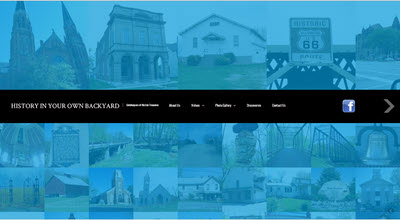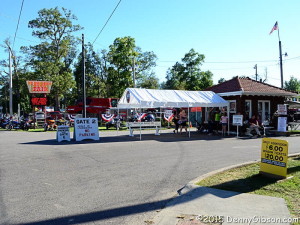 Once upon a time, all of Ohio’s county fairs preceded the state fair but not anymore. In fact, only 29 of the 88 opened their gates before those of the biggie in Columbus this year. When I attended the state fair a few weeks ago, I mentioned that I make it to the fair in my original home county from time to time. This year I made it to The Great Darke County Fair on Monday which is, among other things, Senior Citizens Day. It’s a day when folks over 60 or under 12 and ministers of any age get in free. Yes, I am cheap.
Once upon a time, all of Ohio’s county fairs preceded the state fair but not anymore. In fact, only 29 of the 88 opened their gates before those of the biggie in Columbus this year. When I attended the state fair a few weeks ago, I mentioned that I make it to the fair in my original home county from time to time. This year I made it to The Great Darke County Fair on Monday which is, among other things, Senior Citizens Day. It’s a day when folks over 60 or under 12 and ministers of any age get in free. Yes, I am cheap.
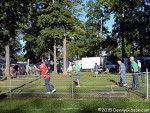
 Darke County is the Horseshoe Pitching Capital of the World so finding a tournament in progress wasn’t much of a surprise. Some of these guys can throw more consecutive ringers than I can take consecutive steps without tripping.
Darke County is the Horseshoe Pitching Capital of the World so finding a tournament in progress wasn’t much of a surprise. Some of these guys can throw more consecutive ringers than I can take consecutive steps without tripping.
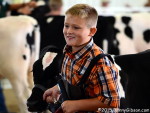
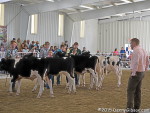 It’s another sort of competition that is at the heart of all fairs and I got to see just a little of the Junior Fair Dairy Show. I believe the fellow in the second picture placed third and he couldn’t have been happier.
It’s another sort of competition that is at the heart of all fairs and I got to see just a little of the Junior Fair Dairy Show. I believe the fellow in the second picture placed third and he couldn’t have been happier.
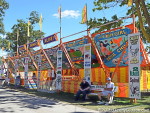
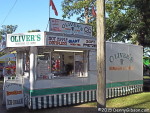
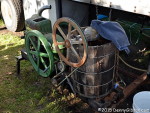 I hate to knock the Ohio State Fair but the only “amazing creatures” I saw there were “The World’s Smallest Woman” and “Snake Girl”. The Great Darke County Fair has a whole menagerie plus a giant horse. Of course, the midway also had plenty of games, rides, and food. The pictured food stand certainly isn’t the flashiest or exotic. I’m including it for personal reasons. I have a real weakness for ice cream made the old-fashioned way in a mixer cranked by an old hit-or-miss engine. Doubly so on an apple dumpling.
I hate to knock the Ohio State Fair but the only “amazing creatures” I saw there were “The World’s Smallest Woman” and “Snake Girl”. The Great Darke County Fair has a whole menagerie plus a giant horse. Of course, the midway also had plenty of games, rides, and food. The pictured food stand certainly isn’t the flashiest or exotic. I’m including it for personal reasons. I have a real weakness for ice cream made the old-fashioned way in a mixer cranked by an old hit-or-miss engine. Doubly so on an apple dumpling.
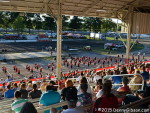
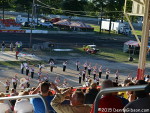
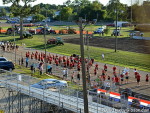 When I saw that this was the day of the High School Marching Band Spectacular, I decided to hang around to see the band from my old school. I got there just a little late and missed one band. It took me awhile but I eventually figured out that the band I had missed was my old school, Ansonia. I still enjoyed the show.
When I saw that this was the day of the High School Marching Band Spectacular, I decided to hang around to see the band from my old school. I got there just a little late and missed one band. It took me awhile but I eventually figured out that the band I had missed was my old school, Ansonia. I still enjoyed the show.

 Even though I get back to the fair every few years, it’s been quite a while since I’ve seen a dark Darke County Fair. I probably should have stayed around to ride to the top of that Ferris wheel but it was getting chilly and I was ready to head home.
Even though I get back to the fair every few years, it’s been quite a while since I’ve seen a dark Darke County Fair. I probably should have stayed around to ride to the top of that Ferris wheel but it was getting chilly and I was ready to head home.
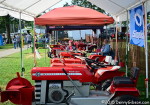
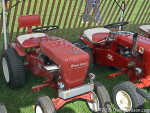
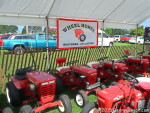 I visited fair grounds again on Thursday but it wasn’t for a fair. It was for the Tri-State Gas Engine and Tractor Association‘s 50th Antique Engine & Tractor Show on the Jay County Fair Grounds in Portland, Indiana. Terry, a long time friend who collects Wheel Horses, has exhibited at the show for many years. Dale, another long time friend, lives reasonably close and has attended the show on several occasions. This was my first time but I knew I’d be in good hands. I arrived a few minutes ahead of Dale which gave me a chance to snap a few pictures of Terry (on left in third picture) and his tractors. The Massey-Ferguson and Simplicities in the foreground belong to Terry’s brother, Joe.
I visited fair grounds again on Thursday but it wasn’t for a fair. It was for the Tri-State Gas Engine and Tractor Association‘s 50th Antique Engine & Tractor Show on the Jay County Fair Grounds in Portland, Indiana. Terry, a long time friend who collects Wheel Horses, has exhibited at the show for many years. Dale, another long time friend, lives reasonably close and has attended the show on several occasions. This was my first time but I knew I’d be in good hands. I arrived a few minutes ahead of Dale which gave me a chance to snap a few pictures of Terry (on left in third picture) and his tractors. The Massey-Ferguson and Simplicities in the foreground belong to Terry’s brother, Joe.
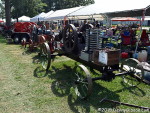
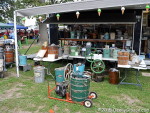
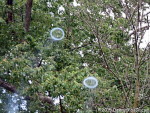 As expected, there was no shortage of gas engines including plenty of the hit and miss variety. A sizable percentage were not running and probably couldn’t without considerable effort while others were hard at work doing things like making (or at least pretending to make) ice cream. Some were running but were just relaxing and blowing smoke rings. One display prompted me to attempt a rare video to show one solution to the aggravation of having an engine that works and a console TV that doesn’t.
As expected, there was no shortage of gas engines including plenty of the hit and miss variety. A sizable percentage were not running and probably couldn’t without considerable effort while others were hard at work doing things like making (or at least pretending to make) ice cream. Some were running but were just relaxing and blowing smoke rings. One display prompted me to attempt a rare video to show one solution to the aggravation of having an engine that works and a console TV that doesn’t.
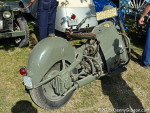

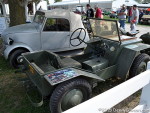 I would quickly discover that the show contained about as many things that I had not anticipated as those that I had. Maybe I should have expected this display of unusual Crosley vehicles, Terry had shown me a photo of the motorcycle from a previous year’s show, but I didn’t. Some, like the motorcycle, are factory prototypes while others, such as the first open-wheeled Crosley-powered racer I’ve ever seen, were aftermarket customs.
I would quickly discover that the show contained about as many things that I had not anticipated as those that I had. Maybe I should have expected this display of unusual Crosley vehicles, Terry had shown me a photo of the motorcycle from a previous year’s show, but I didn’t. Some, like the motorcycle, are factory prototypes while others, such as the first open-wheeled Crosley-powered racer I’ve ever seen, were aftermarket customs.
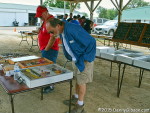

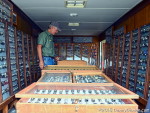 This would have been completely unexpected if I hadn’t heard the announcer mention it over the PA. As soon as I heard the phrase “spark plug collector” I knew it was a hobby as natural — and as endless — as postcard collecting. I was thinking only of the multitude of brands and sizes but soon discovered that there were variations I had never dreamed of. Some early designs had an opening which allowed cylinders to be primed with fuel. Others had two connectors to support both coil and magneto ignitions. There were a variety of multi-piece designs that could be used to fashion quick disconnect plugs so that fouled electrodes could be changed during racing pit stops. Besides being surprised but the many wild plug designs, I was somewhat surprised that Terry and Dale (in the first photo) were almost as unfamiliar with them as I was — but I didn’t let it show.
This would have been completely unexpected if I hadn’t heard the announcer mention it over the PA. As soon as I heard the phrase “spark plug collector” I knew it was a hobby as natural — and as endless — as postcard collecting. I was thinking only of the multitude of brands and sizes but soon discovered that there were variations I had never dreamed of. Some early designs had an opening which allowed cylinders to be primed with fuel. Others had two connectors to support both coil and magneto ignitions. There were a variety of multi-piece designs that could be used to fashion quick disconnect plugs so that fouled electrodes could be changed during racing pit stops. Besides being surprised but the many wild plug designs, I was somewhat surprised that Terry and Dale (in the first photo) were almost as unfamiliar with them as I was — but I didn’t let it show.
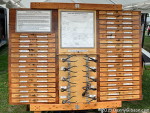 We all learned something here, too. At first I thought it was showing different types of fencing like some barbed wire displays I have seen. Then I thought it might be showing different methods of splicing pieces of wire. The truth was so much better. These are variations of Check Row Planter Wires which were first patented more than 160 years ago. The wires were stretched across a field and carefully placed “buttons” would trigger the dropping of seeds from a sled pulled along their length. A slightly more readable copy of the explanatory placard is here.
We all learned something here, too. At first I thought it was showing different types of fencing like some barbed wire displays I have seen. Then I thought it might be showing different methods of splicing pieces of wire. The truth was so much better. These are variations of Check Row Planter Wires which were first patented more than 160 years ago. The wires were stretched across a field and carefully placed “buttons” would trigger the dropping of seeds from a sled pulled along their length. A slightly more readable copy of the explanatory placard is here.
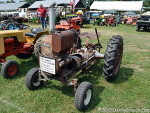
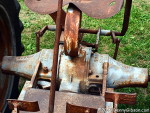 Almost everyone knows about Gibson guitars, greeting cards, wines, appliances, and other items but I doubt many know about Gibson tractors. I didn’t. Produced between 1946 and 1952, internet searches indicate that the tractors were made in Colorado although the company was based in Seattle, Washington. This was an at least rare, if not unique, instance where one 1947 model Gibson took a photograph of another.
Almost everyone knows about Gibson guitars, greeting cards, wines, appliances, and other items but I doubt many know about Gibson tractors. I didn’t. Produced between 1946 and 1952, internet searches indicate that the tractors were made in Colorado although the company was based in Seattle, Washington. This was an at least rare, if not unique, instance where one 1947 model Gibson took a photograph of another.
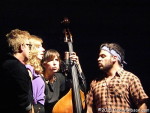 Oh, and one more thing. In between the cows and the tractors, I went to a concert at The Southgate House Revival. Tuesday marked my second time seeing Lake Street Dive. As part of his introduction, WNKU’s Ken Haynes asked how many had also attended their only other area appearance and a number of hands, including mine, went up. “Well,” he said. “They’re two years better.” He was off a little on the calculation (That show was March 4, 2014.) but right on regarding the better and they were fantastic the first time around.
Oh, and one more thing. In between the cows and the tractors, I went to a concert at The Southgate House Revival. Tuesday marked my second time seeing Lake Street Dive. As part of his introduction, WNKU’s Ken Haynes asked how many had also attended their only other area appearance and a number of hands, including mine, went up. “Well,” he said. “They’re two years better.” He was off a little on the calculation (That show was March 4, 2014.) but right on regarding the better and they were fantastic the first time around.

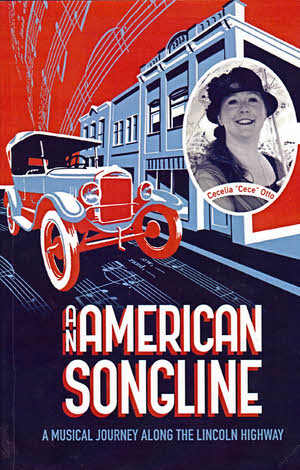 Cece’s a singer… and a traveler and now a writer. Cece (I know the book cover says Cecelia but few actually call her that.) has been singing since childhood. As an adult, she has spent a goodly amount of time singing professionally as a classically trained mezzo-contralto and there was travel, both in and out of the US, involved. Then, just as the career should have been accelerating, a stumbling economy resulted in it instead being sort of paused. Cece used the time to attend workshops and other activities to help in focusing her future. One workshop involved identifying, in a short amount of time, “…five projects you see yourself doing…” and one item on her hurriedly produced list was “singing travelogue”. No one, including Cece, was quite sure what that meant but it sounded intriguing and, before long, she was on her way to defining a real world project that included a coast-to-coast concert tour, a CD, and this book.
Cece’s a singer… and a traveler and now a writer. Cece (I know the book cover says Cecelia but few actually call her that.) has been singing since childhood. As an adult, she has spent a goodly amount of time singing professionally as a classically trained mezzo-contralto and there was travel, both in and out of the US, involved. Then, just as the career should have been accelerating, a stumbling economy resulted in it instead being sort of paused. Cece used the time to attend workshops and other activities to help in focusing her future. One workshop involved identifying, in a short amount of time, “…five projects you see yourself doing…” and one item on her hurriedly produced list was “singing travelogue”. No one, including Cece, was quite sure what that meant but it sounded intriguing and, before long, she was on her way to defining a real world project that included a coast-to-coast concert tour, a CD, and this book.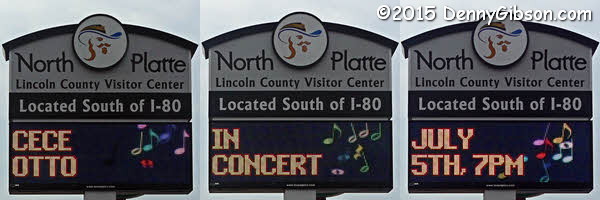
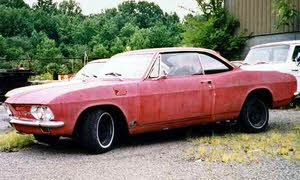 We had apparently become accustomed to being a two car family at this point so, when the blue Nova became a non-runner, I went shopping for another beater. I bought a 1965 Corvair in Kentucky. It didn’t look as ragged as the one at right (which might actually be a ’66) but it probably was. It was a full-on stripper with 3 on-the-floor, bare rubber floor mats, and no perceivable options other than an AM radio and even that might have been standard.
We had apparently become accustomed to being a two car family at this point so, when the blue Nova became a non-runner, I went shopping for another beater. I bought a 1965 Corvair in Kentucky. It didn’t look as ragged as the one at right (which might actually be a ’66) but it probably was. It was a full-on stripper with 3 on-the-floor, bare rubber floor mats, and no perceivable options other than an AM radio and even that might have been standard.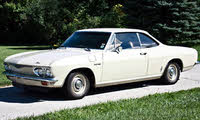
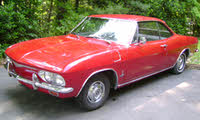 It had begun life as a poor white Chevy and that was still the color of the top. The bottom had been painted fire engine red. It was a decent repaint and still pretty shiny. It was sort of a blend of these two cars minus the fancy wheel covers and all that chrome. It really didn’t look too bad from the proper distance. Up close, something of a reverse freckled look became noticeable. A few chips had appeared in the red part so that bits of the white part showed through. It was a mild case of reverse measles that gave the car “personality”. Yeah. That’s what it was. Personality.
It had begun life as a poor white Chevy and that was still the color of the top. The bottom had been painted fire engine red. It was a decent repaint and still pretty shiny. It was sort of a blend of these two cars minus the fancy wheel covers and all that chrome. It really didn’t look too bad from the proper distance. Up close, something of a reverse freckled look became noticeable. A few chips had appeared in the red part so that bits of the white part showed through. It was a mild case of reverse measles that gave the car “personality”. Yeah. That’s what it was. Personality.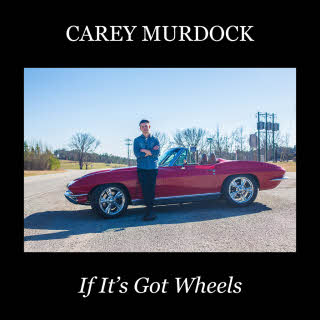 The title song is the opener and I’ll admit I found myself wondering if that was a good thing. “If It’s Got Wheels”, the song, is a V8-powered rocker that heads straight for the horizon like something Springsteen or the Eagles might drive. But then what? Did Murdock pick this tune to lead off and supply the name for his latest album because that’s all there is? The quickly apparent answer is a very loud NO. If It’s Got Wheels, the album, is filled with powerful songs performed by a collection of talented musicians.
The title song is the opener and I’ll admit I found myself wondering if that was a good thing. “If It’s Got Wheels”, the song, is a V8-powered rocker that heads straight for the horizon like something Springsteen or the Eagles might drive. But then what? Did Murdock pick this tune to lead off and supply the name for his latest album because that’s all there is? The quickly apparent answer is a very loud NO. If It’s Got Wheels, the album, is filled with powerful songs performed by a collection of talented musicians.